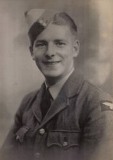Llangwm is a small village, situated south of Haverfordwest on the banks of the River Cleddau. It was well known for its shellfish, most particularly cockles, and also for the quality of a vein of anthracite which was mined locally, at Hook Colliery. The village Church is named in honour of St. Jerome. The original war memorial, to commemorate the fourteen men from the area who fell during the Great War, was erected in Llangwm School and was unveiled in November 1919. The memorial was later moved upon the closure of the school in 2013 and located outside Llangwm Community Centre at Pill Parks. The names of these men are read out in St. Jerome’s Church on Remembrance Sunday each year, and the annual remembrance service is held at the memorial on the village Green.
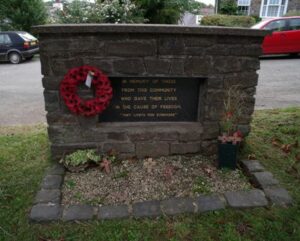
The Great War, 1914-1918
Percy George Adolph, Private, 13150, Welsh Regiment. Percy had been born at Llangwm in 1896, the only son of George Adolph and Mary Adolph (nee John). The family later moved to Continental, Goodwick, Fishguard. Percy enlisted at Haverfordwest into the Welsh Regiment and was later posted to the 1st Battalion, Welsh Regiment. The battalion was stationed in India at the outbreak of war, and was recalled to Britain, where it joined 84 Brigade, 28th Division on 22 December 1914, at Hursley Park. During January 1915 it moved to France, landing at Le Havre and moved to the Western Front, where it saw its first major action during the Second Battle of Ypres. The 1st Welsh landed on 18 January and spent their first night in France in a cotton shed in the Docks at Le Havre, before entraining the following day for Hazebrouck, and marching to Merris. The 1st Welsh then saw their first taste of the front line trenches at Hill 60. After a spell in the line, they rested a few days before moving back into the line at the Bluff on the night of 15 February 1915. The trenches were in an awful state, and not deep enough for safety and during the next two days, the 1st Welsh lost 28 men killed and a further 29 wounded while bringing the trenches up to standard. Percy was killed here on 17 February 1915. He was just 18 years old, and as his grave was lost in further fighting in the area, he is commemorated on the Ypres (Menin Gate) Memorial, Belgium.
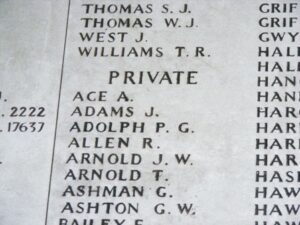
Frederick Bevans, Driver, 91785, Royal Field Artillery. Frederick was born on 16 March 1896, the son of John Bevans and Jane Bevans (nee Cousins), of Trooper’s Inn, Freystrop. He had worked for the Great Western Railway at Neyland as an Engine Cleaner prior the war. He enlisted at Haverfordwest into the Royal Field Artillery, and was posted to A Battery, 66th Brigade, RFA, which was attached to the 13th (Western) Division. On 13 June 1915 the Division sailed for Alexandria, and moved to Mudros before being landed at Cape Helles, Gallipoli from 6 July 1915, relieving the 29th Division. On 8 January 1916, the Division was evacuated from Helles, and by 31 January was concentrated at Port Said, where they held forward posts in the Suez Canal defences. On 12 February 1916 the Division began to move to Mesopotamia, to strengthen the force being assembled for the relief of the besieged garrison at Kut al Amara. By 27 March, the Division had assembled near Sheikh Saad and came under orders of the Tigris Corps, and then took part in the attempts to relieve Kut. Frederick died on an overcrowded troop train during the move into Mesopotamia, on 24 June 1916, aged 20. He is buried in Amara War Cemetery, Iraq. His brother, William John Bevans, was killed in Palestine two years later.
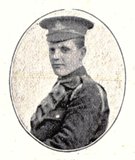
William John Bevans, Private, 200585, Welsh Regiment. William, known as John, was born in 1897, the son of John Bevans and Jane Bevans (nee Cousins), of Trooper’s Inn, Freystrop. He enlisted at Fort Scoveston into the 1/4th Battalion, Welsh Regiment. The battalion was the local Territorial unit and mobilised for war at Carmarthen in August 1914, as part of South Wales Brigade, Welsh Division and moved to Tunbridge Wells until the end of the month, before moving to Scotland to man the Forth and Tay Defences. On 17 April 1915 the battalion moved to Bedford, joining 158 Brigade, 53rd (Welsh) Division. On 19 July 1915 the entire Division sailed from Devonport for Imbros and on 9 August 1915 landed at Suvla Bay. The infantry moved off the beaches across the Salt Lake, under shellfire, into the scrub covered Chocolate Hill, but due to a lack of maps and no knowledge of the terrain, many of the units became disorientated, and the situation became chaotic. The Division remained here throughout the coming months, and suffered severe losses in manpower strength during the great November 1915 blizzard on Gallipoli, when its total strength was reduced to less than that of a full-strength Brigade. On 11 December 1915 the Division was evacuated to Mudros, and by 23 December 1915 were moved to Egypt. They remained on the Suez Canal Defences for the next twelve months, where it took part in operations against the Sultan of Darfur, and in March 1917 took part in the advance into Palestine, taking part in the three Battles of Gaza, before helping capture Jerusalem. The division then continued its advance through Northern Palestine over the coming months. John was killed during the drive through northern Palestine on 9 March 1918. The 18-year-old is buried in Jerusalem War Cemetery, Egypt. His elder brother Frederick had been killed in Iraq when men on an overloaded troop train were suffocated in stifling heat.
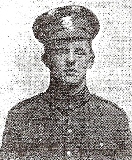
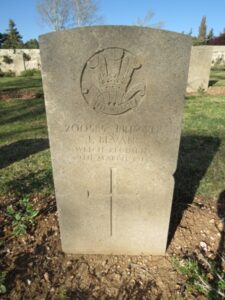
Herbert Leslie Brock, Lieutenant, Machine Gun Corps. Herbert was born in Penrhyndeudraeth in 1890, the eldest son of William and Annie Brock. His father was from Llangwm, but in his work as a teacher had taken up a post as headmaster in Tregarth National School, after having moved his young family to Sunnyside, Tregarth. Herbert had entered Bangor University after gaining a scholarship in 1908 and studied for his BA, before taking up a teaching post at the Elmfield College in York. In February 1915 he enlisted into the 14th Battalion, Royal Welsh Fusiliers. An intelligent man, he was commissioned as a second lieutenant prior to embarking for France with the 38th (Welsh) Division on 1 December 1915, and was wounded during a very succesful trench raid during the night of 4/5 June 1916, which required him to spend some time in hospital. Upon recovering he embarked once more for France and was posted to the 29th Company, Machine Gun Corps. Herbert was killed in action somewhere in the Lys Valley, on 10 April 1918. He was 27 years old and is commemorated on the Ploegsteert Memorial, Belgium. His brother James had been killed some months earlier. Neither are commemorated at Llangwm, although both men are commemorated at St. Mary’s Church, Tregarth.
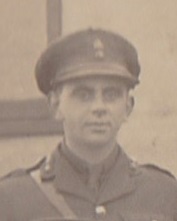
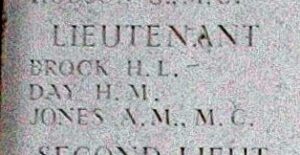
James Ifor Baxter Brock, Private, 267871, Royal Welsh Fusiliers. James was born in Tregarth in 1898, the third and youngest son of William and Annie Brock. His father was from Llangwm, but in his work as a teacher had taken up a post as headmaster in Tregarth, after having moved his young family to Sunnyside, Tregarth. James enlisted into the Royal Welsh Fusiliers alongside his brother, and was posted to France on 1 December 1915 with the 14th Battalion, Royal Welsh Fusiliers, which was attached to the 38th (Welsh) Division. He would have taken part in the divisions famous assault on Mametz Wood during July 1916 and during the following year took part in its capture of the Pilckem Ridge on 31 July 1917. On 1 September 1917 the battalion was back in the front line, near Iron Cross, when battalion HQ was hit by German artillery fire. There was no major damage, apart from woodwork at the entrance being set ablaze, but the dugout was evacuated for a while. After sometime a party of officers and men returned, but unfortunately the blaze ignited a box of grenades, bringing the dugout down. James was most probably the one man killed in the explosion, while three officers and seven men were wounded. He was 20 years old and is commemorated on the Tyne Cot Memorial, Belgium. His official date of death is 2 September 1917, but the battalion war diary mentions no casualties on that date, so either the diary is wrong or the official records are. His brother Herbert was killed some months later. Neither are commemorated at Llangwm, although both men are commemorated at St. Mary’s Church, Tregarth.
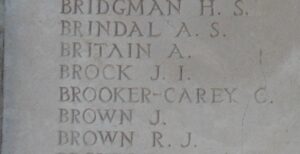
John Davies, Rifleman, 48376, London Regiment. John was born at Haverfordwest in 1882, the son of John Davies and Ann Davies. He trained as a monumental mason, before moving with his widowed mother to 10, Rock Street, Mountain Ash, where he ran his own business. John married Rhoda Margaret Brown, of The Shop, Hill Mountain on 4 March 1917. Rhoda was a schoolteacher at Rosemarket School. John had enlisted at Mountain Ash into the South Wales Borderers, with the Regimental Number 30486. He later transferred into the 1/28th Battalion (Artists Rifles), London Regiment, which was attached to 190 Brigade, 63rd (Royal Naval) Division. The division saw its first major action during the Second Battle of Passchendaele in October 1917, where heavy casualties were suffered during terrible conditions. The division was then transferred to the Arras sector and took place in the Battle of Cambrai, seeing especially heavy fighting during the Action of Welsh Ridge. The division was still in the area when the Germans launched their Spring Offensive on 21 March 1918 and took part in a gallant rear-guard action as the line was driven back by the Germans. The Germans then switched their attention away to the Lys Valley on 9 April and the sector held by the Royal Naval Division at the Northern edge of the Somme sector quietened down. John was killed in action whilst the Artist’s Rifles were holding a section of the line in Aveluy Wood on 1 June 1918. The 36-year-old is buried in Varennes Military Cemetery, France. John is not commemorated at Llangwm.
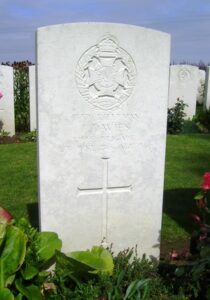
David Harries George, Trooper, 1900, Cavalry. David was the son of George Protheroe George and Elizabeth Anne George, of Great Nash Farm, Haverfordwest. He enlisted on 16 October 1914 into the Royal Horse Guards (The Blues). At the outbreak of war, the Blues were stationed at Windsor, and mobilised to join the 8th Cavalry Brigade, 3rd Cavalry Division, and landed at Zeebrugge on 7 October 1914. David served with the Blues through the Battles of Ypres, and returned home ill at some time, probably due to the terrible conditions in the trenches. He died of appendicitis at the 3rd London General Hospital, Wandsworth on 8 September 1917, aged 23, and is buried in Pill Park Cemetery, Llangwm.
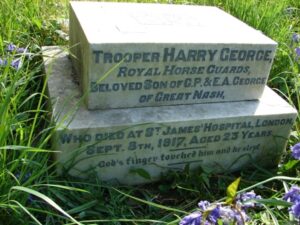
William Henry Hitchings, Private, 203690, East Yorkshire Regiment. William was the son of Frederick and Sarah Hitchings, of Sprinkle Hill, Hook. He enlisted at Cardiff into the Army, and was posted to the 1/4th Battalion, East Yorkshire Regiment, which was attached to 150 Brigade, 50th (Northumbrian) Division. It moved to France 16 April 1915, and served with distinction on the Western Front throughout the war. The Division moved to Ypres, where they took part in the Second Battle of Ypres from April to June 1915. During the summer of 1916 the Division were on the Somme, where they fought at the Battle of Flers-Courcelette, the Battle of Morval and the Battle of Le Transloy. After spending a winter on the Somme, they moved north to Arras, where they took part in the Arras Offensive of April 1917, and fought at the First Battle of the Scarpe, capturing the Wancourt Ridge. William was killed at Arras on 23 April 1917, aged 21, and is commemorated on the Arras Memorial, France.
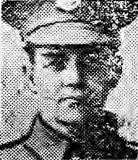
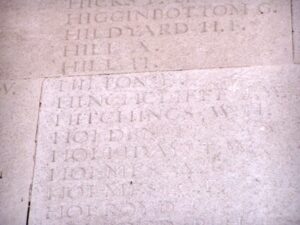
Fred Hughes, Private, 464768, Labour Corps. Fred was born in 1892, the son of John Hughes and Elizabeth Hughes (nee Clarke), of Guilford, Llangwm. He worked as a fisherman with his father prior to enlisting into the Pembroke Yeomanry. Fred was deemed as unfit for front-line service, so was later transferred to the 683rd Agricultural Company, Labour Corps, which was in the Peterborough area. Fred contracted phthisis whilst on active duty with the company during the latter months of the war and was discharged from the army as medically unfit on 3 September, 1918, returning home to Llangwm. Following a long period of ill-health, he died of pthisis on 4 February 1921, aged 28. Nothing further is currently known of Fred, as he is not commemorated as a casualty of war by the CWGC. I am currently working on his case, to see if I can get enough evidence to send it to them for adjudication. Fred is not commemorated on the Llangwm war memorial.
John Hutchings, Private, 201971, Welsh Regiment. John was born at Llangwm, the son of Simon and Martha Hutchings. He enlisted at Pembroke Dock into the Welsh Regiment, and was posted to the 18th Battalion, which was attached to 119 Brigade, 40th (Bantam) Division. This Division was formed between September and December 1915, composed of bantam units and others which had a mixture of regulation-height and shorter men. Weeding out of very under-sized or unfit men delayed the training programme, and it was not until late spring 1916 that the Division was ready to proceed on active service. The Division moved to France between 1-9 June, and moved to the front near Loos. Late in 1916 they moved south to the Somme, and fought at the Battle of the Ancre, and remained in the area over the winter. In March, 1917 the Germans withdrew to their shortened line, called the Hindenburg Line, and the 40th Division were one of the Divisions that followed the withdrawal. Later in the year they took part in the Battle of Cambrai, playing an important role in the attack on Bourlon Wood. John was killed in action at Bourlon Wood on 24 November 1917, aged 36. He is commemorated on the Cambrai Memorial, Louverval, France.
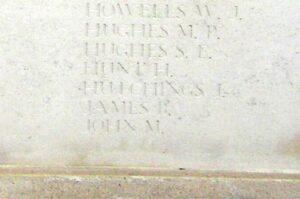
Bertie Jenkins, M22936, Royal Navy, HMS Ampritrite. Bertram (Bertie) was born on 15 August 1895, the son of William and Anne Jenkins, of Guildford, Burton. Bertie and his father worked at Pembroke Dockyard prior to the war, and on 19 September 1916, Bertie enlisted into the Royal Navy. After training at HMS Victory, in Portsmouth, Bertie was posted to HMS Amphitrite. HMS Amphitrite was a Diadem-class Cruisers, which had been built at Vickers Limited, Barrow in Furness and launched on 5 January 1898. At the outbreak of was she was part of the Ninth Cruiser Squadron, serving in the Atlantic. In June 1915 she was placed in reserve, but reactivated as a minelayer in 1917, which is when Bertie joined her crew. Bertie took ill with chronic bronchitis while serving aboard Amphritrite, and was hospitalised at Portsmouth. He was discharged on 14 February 1918, but died at 24, Prospect Place, Pembroke Dock of Bronchitis on 5 May 1918, aged 21. Bertie was accepted for commemoration by the CWGC on 6 April 2012. There is a headstone in Llangwm Cemetery commemorating Bertie but the burial register does not show him being interred there, so Bertie is commemorated on the Addenda Panel of the Portsmouth Naval Memorial, Hampshire. Many thanks to Richard Horton for finding Bertie’s headstone and for sending photographs of it in.
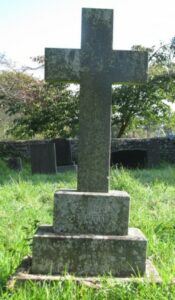
Edwin Arthur John, Private, 624939, Canadian Expeditionary Force. Edwin was born at Derby Farm, near Merlins Bridge, on 11 April 1893, the son of Arthur and Jane John. The family emigrated to Canada in 1904, embarking from Liverpool aboard SS Bavarian on 22 September, and arrived at Montreal. They then set up home at Erskine, Alberta, before moving on to Turgoose, British Columbia. Edwin enlisted into the Canadian Infantry at Stettler, Alberta, on 22 February 1916, and joined the 151st Overseas Battalion, CEF. Edwin then travelled to Britain, where he joined the reinforcements for the 50th Alberta Regiment, which was attached to the 10th Canadian Brigade, 4th Canadian Division. The battalion arrived in France in August 1916, and fought through the later Battles on the Somme in 1916. In April 1917 it took part in the Battle of Vimy Ridge, and remained on the Arras front afterwards, where it took part in The Battle of Hill 70. On 25 August 1917 the 50th Battalion was tasked with the capture of Aloof Trench. Edwin and his brother John were both killed here that day, on 25 August 1917, when Edwin was hit by a sniper during the assault. John fell while cradling the body of his dead brother. Edwin was 24 years old, and is commemorated alongside his brother on the Vimy Memorial, France.
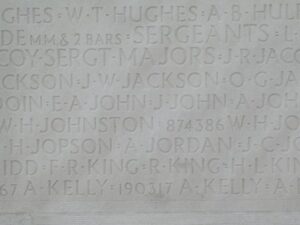
James John, Private, 883636, Canadian Expeditionary Force. James was born at Derby Farm, near Merlins Bridge, on 17 July 1888, the son of Arthur and Jane John. The family emigrated to Canada in 1904, embarking from Liverpool aboard SS Bavarian on 22 September, and arrived at Montreal. They then set up home at Erskine, Alberta, before moving on to Turgoose, British Columbia. James followed the lead of his brother Edwin, and enlisted at Stettler, Alberta on 1 August 1916 into the 151st Overseas Battalion, CEF, and travelled to Britain, where he was posted to join the same battalion as Edwin, the 50th Alberta Regiment, attached to the 10th Canadian Brigade, 4th Canadian Division. The battalion arrived in France in August 1916, and fought through the later Battles on the Somme in 1916. In April 1917 it took part in the Battle of Vimy Ridge, and remained on the Arras front afterwards, where it took part in The Battle of Hill 70. On 25 August 1917 the 50th Battalion was tasked with the capture of Aloof Trench. Edwin and his brother John were both killed here that day, on 25 August 1917, when Edwin was hit by a sniper during the assault. John fell while cradling the body of his dead brother. John was 19 years old, and is commemorated alongside his brother on the Vimy Memorial, France.

William John Jones, Private, 55216, Hampshire Regiment. William was born in 1896, the son of Thomas Jones and Ann Jones (nee Morris), of Edwards Pill, Llangwm. He had worked as a fisherman with his father prior to enlisting at Inverness into the army. William was drafted out to France in the summer of 1918 and was posted to the 2nd Battalion, Hampshire Regiment, which was attached to 88 Brigade, 29th Division. The Division had taken part in the Gallipoli Landings of 25 April 1915, before moving to the Western Front in 1916, where it took the line opposite Beaumont Hamel leading up to the Somme Battles, and was decimated here on 1 July 1916. It saw heavy fighting during most of the major offensives on the Western Front during the coming years, before being almost annihilated during the German Spring Offensive in April 1918 and was heavily rebuilt. The battalion spent much of June and July 1918 at Lumbres, training and refitting, before moving to positions near Eecke. To the south, the Allies launched a great offensive along the Somme front on 21 August 1918 and following a rapid advance, began attacking from their positions along the Flanders front. The 29th Division attacked from the Armentieres area at the beginning of September, driving towards positions south of Ypres, then along the Menin Road over the coming weeks. William was killed at Ypres on 20 October 1918. The 22-year-old has no known grave and is commemorated on the Tyne Cot Memorial, Belgium.
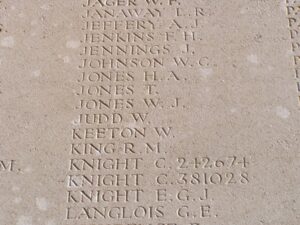
George Lewis, Ordinary Seaman, J/79048, Royal Navy. George was born at Llangwm on 3 October 1898, the son of Benjamin and Elizabeth Lewis. The family later resided at 22, Eva Street, Neath. George enlisted into the Royal Navy, and by 1918 was serving aboard HMS Louvain, which was an armed boarding steamer. On 20 January 1918, Louvain was being used as a troop carrier in the Aegean, when she was spotted by the German submarine UC22. The submarine fired off a single torpedo, which struck Louvain, sending her immediately to the bottom. George was among over 140 men killed aboard Louvain when she was sunk that morning. He was 20 years old, and is commemorated on the Plymouth Naval Memorial, Devon.
Stephen Arla Phillips, Armourer, 340270, Royal Navy. Stephen was born on 5 October 1870, the son of Thomas Phillips and Sarah Phillips (nee Prout), of Cresswell Quay, Begelly. He had worked as a blacksmith prior to enlisting into the Royal Navy on 29 May 1894 and was posted to HMS Cambridge, before being transferred to HMS Vivid II, for training as an Armourer. Stephen married Hannah Palmer, of Black Tar, Llangwm, on 2 January 1897, whilst home on leave. He continued to serve in the Royal Navy as a regular over the coming years, and following the outbreak of war was posted aboard the armoured cruiser HMS Aboukir. Aboukir had been launched in 1900, and at the outbreak of war was sent along with her sister ships Bacchante, Euryalus, Hogue and Cressy to patrol the North Sea. At around 6 am on 22 September the three cruisers were steaming at 10 knots in line ahead and they were spotted by the U-9, commanded by Lt. Otto Weddigen. Although they were not zigzagging, all of the ships had lookouts posted to search for periscopes and one gun on each side of each ship was manned. Weddigen ordered his submarine to submerge and closed the range to the unsuspecting British ships. At close range, he fired a single torpedo at the Aboukir. The torpedo broke the back of the Aboukir and she sank within 20 minutes with the loss of 527 men. The captains of the Cressy and Hogue thought the Aboukir had struck a floating mine and came forward to assist her. They stood by and began to pick up survivors. At this point, Weddigen fired two torpedoes into the Hogue, mortally wounding that ship. As the Hogue sank, the captain of the Cressy realised that the squadron was being attacked by a submarine, and tried to flee. However, Weddigen fired two more torpedoes into the Cressy, and sank her as well. The entire battle had lasted less than two hours, and cost the British three warships, 62 officers and 1,397 ratings. Stephen was 45 years old when he was killed in the sinking of Aboukir that day. He has no known grave but the sea, so is commemorated on the Chatham Naval Memorial, Kent. His grandson, William Arla George, was killed during the Second World War.
James Henry Skyrme, Stoker 1st Class, 296150, Royal Navy. James was born on 20 May 1882, the son of William Skyrme and Jane Skyrme (nee Jones), of Williamston Terrace, Guildford, Llangwm. He enlisted into the Royal Navy on 23 October 1900 and was posted to HMS Vivid II for training. James married a local woman, Olive Annie Peart, in 1907 and two years later their only child, Oliver Peart Skyrme, was born. Olive raised their son at 5, Ainslie Terrace, Devonport, whilst James continued to serve with the Royal Navy. On 2 April 1913 James was posted aboard the newly launched scout cruiser HMS Amphion, which was stationed in the English Channel. Just after the outbreak of war, during the afternoon of 6 August 1914, Amphion was patrolling in the Channel when she struck a mine which had been laid earlier that day by a German minelayer. She blew up and sank almost immediately, with the loss of 150 lives. Among the dead was James Skyrme. The 33-year-old has no known grave but the sea, so is commemorated on the Plymouth Naval Memorial, Devon. Amphion was the first Royal Naval ship to be sunk in the course of the Great War.
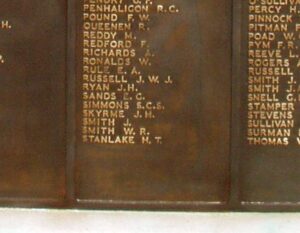
James Charles Thomas, Private, 85944, Machine Gun Corps. James was the son of James and Ann Thomas, of Tally Hoo Farm, Llangwm. He enlisted at Pembroke into the 4th Battalion, Welsh Regiment on 3 December 1915, being allotted the service number 6462. James was posted to France on 11 July 1917, joining the 235th Company, Machine Gun Corps, which was attached to the 12th (Eastern) Division. The Division had been in France since 31 May 1915, and had fought at the Battle of Loos in 1915, and at the Somme in 1916. James joined his new unit at Arras, where it was rebuilding after taking part in the Battles of Arras. The Division remained at Arras until taking part in the Battle of Cambrai in November, 1917. James was wounded and taken prisoner at Cambrai in November, and died of his wounds on 4 December 1917. He was 26 years old, and was buried by the Germans at Caudry British Cemetery, France.
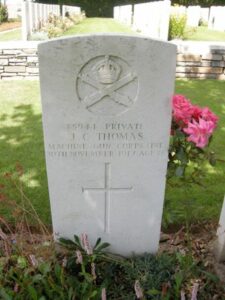
Arthur Williams, Lance Corporal, 11541, South Wales Borderers. Arthur was born at Llangwm, Pembrokeshire in 1896, the son of Thomas Williams and Mary Jane Williams (nee Probert). The family was residing at 15, Newgate Street, Llanfaes, Brecon by 1901. Arthur enlisted at Brecon into the South Wales Borderers soon after the outbreak of war. After completing his training, he was drafted to France on 4 January 1915, joining the 1st Battalion, South Wales Borderers, which was attached to 3 Brigade, 1st Division. Arthur joined the battalion at Festubert, as part of a large draft of 240 men. The 1st Division, holding the line near Givenchy, took part in its first major action of 1915 here on 9 May 1915, during the Battle of Aubers Ridge, when it attacked alongside the Meerut Division. The attack of 3 Brigade was held up by a flooded ditch, which the men forded, before being hit by heavy machine-gun fire, and a large number of casualties were suffered before the survivors withdrew. The Division then saw further heavy fighting at the Battle of Aubers, before moving South to Loos, and saw heavy fighting during the Battle of Loos, and the action at the Hohenzollern redoubt from 25 September. The 1st Division wintered in the Loos sector, before moving south to the Somme at the beginning of July 1916. Arthur came home on leave whilst his battalion was on the move but returned to France in time to take part in the heavy fighting for Bazentin Ridge, where he was wounded. He was eventually invalided home, suffering from multiple wounds, and spent several months recuperating before being drafted back out to France, joining the 2nd Battalion, South Wales Borderers. The battalion was in the Arras sector, attached to 87 Brigade, 29th Division, and Arthur probably arrived in time to take part in the heavy fighting for Monchy-le-Preux. The division then moved further north to Ypres, initially to hold the line whilst other units had been withdrawn for specialist training, in readiness for the Third Battle of Ypres, which opened on 31 July 1917. The 29th Division went into reserve whilst the first attacks, the Battle of Pilckem Ridge, took place, then on the night of 14-15 August the 2nd SWB moved into the line facing Langemarck, ready to launch another offensive. On the following day the battalion reconnoitred the ground in front of them, and laid white tapes in No Man’s Land, to guide the attacking troops, and at dawn on 16 August 1917 the 2nd SWB launched an attack on Langemarck. The battalion successfully took its two objectives but had suffered 163 casualties. The Division then had another period out of the line to rest and refit before taking part in further fighting near Poelcapelle. Arthur was mortally wounded here and was evacuated to the Casualty Clearing Station at Dozinghem where he died of his wounds on 6 October 1917. The 21-year-old was buried in Dozinghem Military Cemetery, Belgium. Arthur is not commemorated at Llangwm.
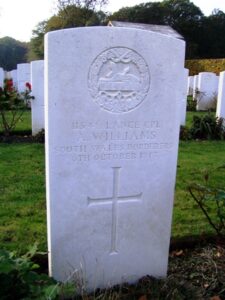
World War Two, 1939-1945
Dennis Charles Ellis, Private, 14684346, York and Lancaster Regiment. Dennis was born in 1924, the son of George Ellis and Matilda Maud Ann Ellis, of The Bungalow, Black Tar, Llangwm. He enlisted into the army and was posted to the Hallamshire Battalion, York and Lancaster Regiment. The battalion had trained for the invasion of North West Europe in Scotland, and landed in France as part of 146 Infantry Brigade on 9 June 1944, moving into the front line four days later. A fortnight after landing, the Hallamshires were involved in the attack on Fontnay-le-Pesnil against the 26th Panzer Grenadier Regiment. The battalion was then involved in the capture of the docks at Le Havre, before taking part in the advance through Northern France into Belgium and Holland. During September 1944, the Hallamshires crossed the Antwerp-Turnhout canal. Dennis was killed during the advance, on 26 September 1944. He was 19 years old, and is buried in Lier Belgian Military Cemetery, Antwerpen. Dennis is not commemorated at Llangwm.
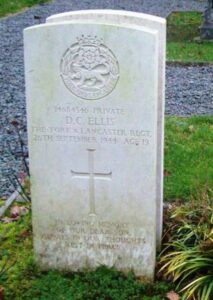
William Kenneth Fuller, Craftsman, 3961543, Royal Electrical and Mechanical Engineers. William was born at Llanelli in 1921, the son of John Fuller and Mary Fuller (nee Palmer). His mother was a young woman from Llangwm who had worked as a servant at Haverfordwest before her marriage, then the family had moved to 14, Pencae Terrace, Llanelli. William had enlisted into the Welch Regiment, but was later transferred to the 2nd Infantry Brigade Workshop, Royal Electrical and Mechanical Engineers. He then served in North Africa, and following the surrender of the Afrika Korps, joined the great offensive to liberate mainland Italy. William was killed during the invasion of Italy on 18 February 1944. He was 22 years old, and is buried in Anzio War Cemetery, Italy.
William Arla George, Sergeant (Air Gunner), 1709173, Royal Air Force Volunteer Reserve. William was born on 2 February 1924, the son of James Clifford George and Violet Alexandra George (nee Phillips), of Black Tar, Llangwm. He was given the middle name Arla after his grandfather, Stephen Arla Phillips, who was killed during the Great War. William enlisted into the Royal Air Force Volunteer Reserve and after completing his training as an Air Gunner, was posted to 460 (RAAF) Squadron, which was equipped with the Avro Lancaster. On 2 February 1945, William was aboard Lancaster AR-P ME326. The aircraft was returning from a raid on Wiesbaden when it collided with another Lancaster of 626 Squadron, and both crashed at St-Maxent (Somme), five miles southwest of Abbeville, in the Somme Valley. William was one of seven men killed aboard his Lancaster that day. He was 20 years old, and is buried in Abbeville Communal Cemetery Extension, France.
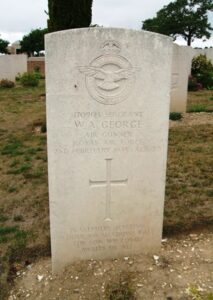
Ronald Palmer, Sergeant (Pilot), 1651825, Royal Air Force Volunteer Reserve. Ronald was born in 1923, the son of Trevor Palmer, and of Lena Palmer (nee Jones), of 5, Chapel Row, Llangwm. He trained as a Pilot with the Royal Air Force Volunteer Reserve, before being posted to 127 Squadron, which was a fighter Squadron, equipped at first with the Hawker Hurricane, then with the Supermarine Spitfire. Ronald was killed when his Spitfire RR212 stalled during take off from Schindel in Holland on 6 April 1945, and crashed. He was 22 years old, and is buried in Bergen-op-Zoom War Cemetery, Netherlands.
